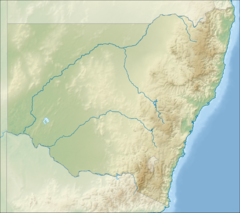Ben Boyd National Park
| Ben Boyd National Park | ||
|---|---|---|
| Ben Boyd Tower | ||
|
|
||
| Location: | New South Wales , Australia | |
| Specialty: | Red sandstone gorges, observation tower | |
| Surface: | 104 km² | |
| Founding: | 1971 | |
| The Pinnacles : White sand overlaid the red clay | ||
The Ben Boyd National Park is a national park in the extreme southeast of the Australian state of New South Wales , 382 km south of Sydney . It was named after Benjamin Boyd (1801-1851), an Australian entrepreneur. He ran a number of shops in the very south of the New South Wales coast. B. Agriculture and whaling. The national park was established in 1971. At first it covered an area of 8900 hectares ; later it was expanded to 9,455 hectares and today it is 10,400 hectares.
Boyd commissioned the construction of a sandstone tower that towered over the entrance to the harbor in Twofold Bay . It was supposed to be used to alert the whalers when the whales approached, but it was never done.
The park consists of two parts on either side of Twofold Bay and the town of Eden . The smaller, northern part is bounded to the west by the Princes Highway . Geologically, this part consists primarily of sedimentary rock ( iron ore and clay ) that was deposited in the paleogene . Quartzite is embedded . The main attraction for tourists are The Pinnacles , a multi-colored erosion canyon with layers of white sand deposited on the rust-red clay. The southern part of the coastline is metamorphic and originated in the Devonian . There are some heavily folded sections at Red Point near the Boyd Tower.
The area of the park is almost flat; no point in the northern part exceeds a height of 100 m. The southern part is not much higher; the highest point is Haycock Hill at 252 m. The area is very windy, dry and cold and the coastal regions are covered by low heathland. Further inland there is a loose eucalyptus forest that covers most of the park area. The two most important tree species there are Eucalyptus sieberi and Corymbia gummifera . In narrow valleys and gorges there are also some places with rainforest with plant species such as Synoum glandulosum or Notalaea venosa .
212 species of birds have been registered in the park. The little tern breeds in the sand dunes and on the beaches, but is threatened by off-road and beach buggy drivers. 50 species of mammals were also found.
Pests are z. B. Cats and foxes, both of which have spread in the park, and occasionally wild dogs and rabbits in cleared areas and picnic areas. The Bitou bush ( Chrysanthemoides monilifera ) spreads as a weed north of the Pambula River .
Web links
- Ben Boyd National Park . New South Wales Department of Environment and Climate Change. NSW National Parks and Wildlife Service
Individual evidence
- ↑ a b c d e f g Peter Wright: National Parks of Southern NSW . Bridge Printery, Rosebery NSW 1996, ISBN 0-9587590-1-4 , pp. 220-225
- ↑ Ben Boyd Tower . SeaSide Lights
- ↑ Ben Boyd National Park: Native vegetation . Office of Environment & Heritage. NSW Government
- ↑ Ben Boyd National Park: Native animals . Office of Environment & Heritage. NSW Government
- ↑ Ben Boyd National Park: Pest animals and weeds . Office of Environment & Heritage. NSW Government


